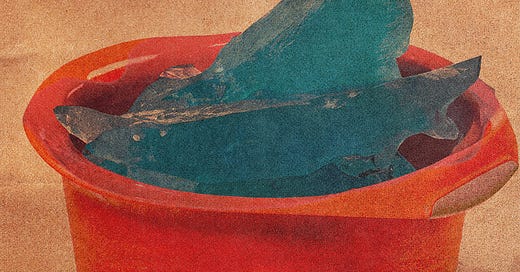I first said this phrase/image, to demonstrate the indeterminate and overwhelming scale of the Wicked Problems1 that encircle us today. The emblematic plastic bucket with a gigantic melting iceberg mimics the paradox and impossibility of a hyperbolic structure fitting into the small space of our cognition. I thought it was funny at the time, but since then, it's come back to bite me. I ended up creating the image so that I could see it from the outside. Of course, imaginary images have unrealisable dimensions and movements because the overwhelming dance of time and space scales between the bucket and the iceberg is something disconcerting in the living image that has haunted me.
It now appears to me as a poignant metaphor for modernity in its inescapable rawness: a simple everyday object used for cleaning (we all have at least one at home), made of plastic, with a gigantic iceberg inside. The Iceberg melts and disappears, but the bucket remains. Inexorable. The colossal frozen biome drains away. But the bucket persists, only silently and lifelessly. Aseptic and clean, but without a soul.
The Plastic Psyche
The Plastic Psyche has various aseptic, dogmatic and crystallised facets. From superficial transcendent spirituality to narcissistic influencer-pop style self-knowledge, that's for another time. Like plastic and many other pollutants produced by modernity, the Plastic Psyche claims itself outside, pseudo-transcending the necessary cycle of decomposition, putrefaction or rotting - or the insidious quest for immortality. Assuming a coldness to distance herself from what might affect her - after all, emotional control equals maturity, right? Stubbornly and hubristically resisting belonging and dissolving in the cycle of Life. It claims immortality and perpetuity, chemical and material, in a presence that accumulates, increasingly dissociated, heavy and toxic. The Plastic Psyche is limited, anthropocentric and reductive. The Plastic Psyche inexorably tries to replicate, in a crystallised and dogmatic way, pure or classic versions of methods and structures, usually without considering the specificities of the context in which it operates.
For all this, the Plastic Psyche also refers to denial and dissociation in the implication of the damage perpetrated by the comfort of modernity and the profound limitation of imagination and possibilities outside the spectrum of the domesticated metabolism. And it's the latter that I'm referring to here, the restriction of our (my) imagination.
I mean that in a real confrontation between a bucket and an Iceberg, the bucket would be outright defeated! Even the millions of tonnes of plastic adrift in the ocean, if we consider the deep time of the geological eras.
Despite all the profound temperature changes we see today, the vastness, weight and countless eras and cycles contained in an iceberg would devour and crush a plastic bucket. Obvious! Despite the insidious perenniality of plastic, it is still relatively young when measured against the perpetuity and range of the world's ice sheets.
This image that haunts me as an archetype of modernity is incomplete in its cycle.
Like the Plastic Psyche, it is truncated in the unfolding movement of Life, shackled in the possibilities of seeing outside itself, having learnt to remain privileged and impermeable as a response to a world in collapse.
I realise now, the integral image would consider the water left by the melting Iceberg. Alive and pulsating water, forging the complex processes that make life emerge, would remain in deep time. The metaphorical Plastic Bucket, the one that prevailed in the encounter with a thousand-year-old Iceberg, would inevitably be digested by larvae and fungi, decomposed and put to the service of the nutrition that supports Life.
After all, living archetypal images are always surprising, just as in a dream they radiate astonishing trails if you let them loose!
Wikipedia states that a Wicked Problem is “a problem that is difficult or impossible to solve because of incomplete, contradictory, and changing requirements that are often difficult to recognize.”





